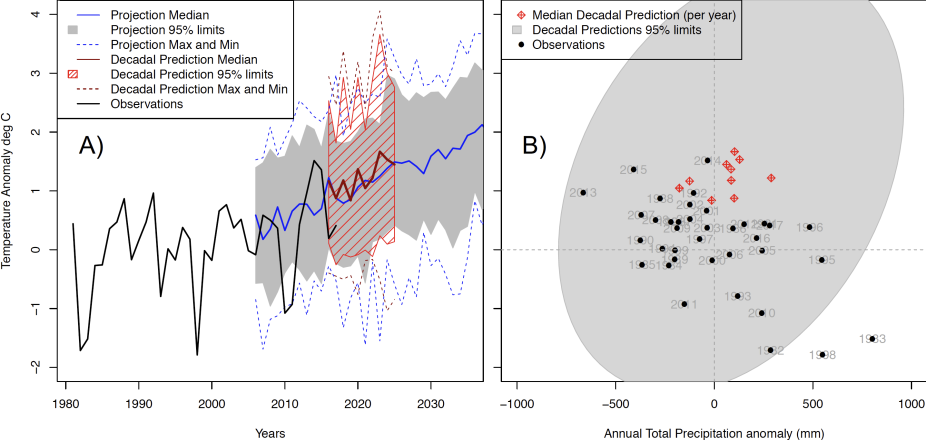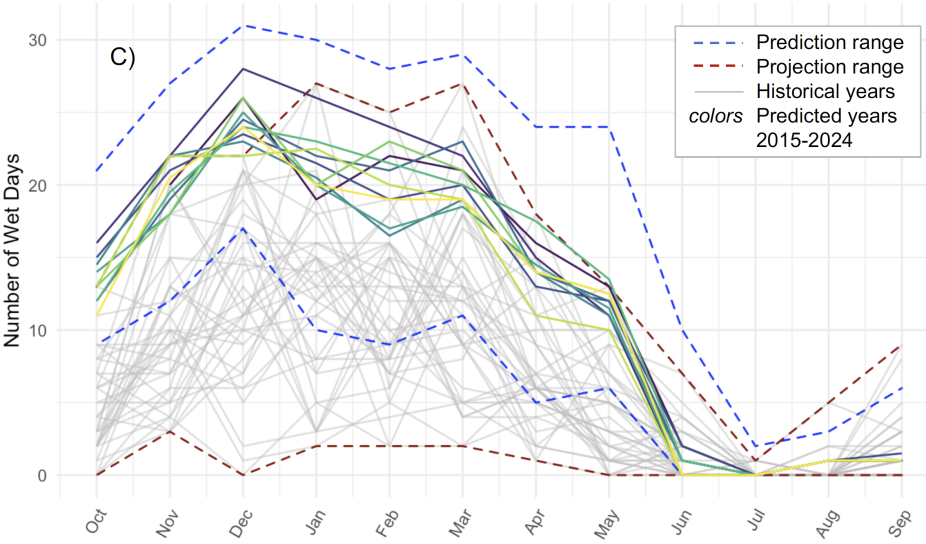UDECIDE Products
Overview
UDECIDE delivered a variety of products, including images of decadal climate predictions, academic publications, and presentations at industry and academic meetings. Products are list on the page below:
Decadal Prediction Images
We developed images of decadal prediction data that built on initial results of our stakeholder-oriented and climate research streams. We took these images to meetings with stakeholders to explore how predictive information could be provided in usable ways.
The images consisted of four broader outlooks to explore the general utility of decadal predictions and three hydrologic predictions generated by Jacobs relevant to specific water management decisions in a format that agencies are familiar with.
Figure 1 shows three examples of the images.
The image in Fig. 1A was designed to test the value of decadal climate prediction relative to longer timescale climate projections, and serves as a bridge back to stakeholders’ familiarity with climate projections.
The image in Fig. 1B was designed to test multi-variate vs. univariate information, and is responsive to concurrent management needs against multiple climate drivers of risk.
The image in Fig. 1C was designed to test the value of statistical properties of higher frequency (in this case, precipitation days) information, motivated by results of our numerical model investigation and stakeholder desires to explore the timings of weather events.


Figure 1. Three of the seven images designed to probe specific aspects of the decadal timescale and how it intersects with decision making by California water managers. A) Annual mean daily maximum 2m temperature anomaly for historical observations (black line), the median of a 40-member climate projection from 2006 to 2040 (blue line), and the median of a 40-member climate prediction from 2015 to 2024 (red line). The gray shading is the 95% confidence limits on the projection, and the blue dashed lines are the minimum and maximum values. The red shading is the 95% confidence limits and red dashed lines are the minimum and maximum values. Based on Fig. 11.9 in Kirtman et al. (2013) B) Combined annual mean daily maximum 2m temperature (y-axis) and annual total precipitation (x-axis) anomalies for historical observations over the period 1981-2017 (black dots), and the median of a 40-member decadal prediction for each year from 2015-2024 (red diamonds). The gray ellipse is the 95% confidence bounds on the predictions. The dashed lines indicate climatology, dividing the chart into quadrants of wetter, drier, warmer and cooler. C) Number of wet days for observed historical years (gray lines), ensemble mean predicted years from to 2015 to 2024 (colored solid lines). The range of the prediction is shown in the blue dashed lines and the range of a climate projection is shown in the red dashed lines. For all panels, anomalies are from the observed 30-year climatology 1981-2010, and are averaged over the Sacramento River Hydrologic Region. Observations use PRISM data (Daly et al. 2008), predictions use DPLE (Yeager et al. 2018) and projections used LENS (Kay et al. 2015). Figure taken from Done et al. (submitted).
References
Daly, C., Halbleib, M., Smith, J.I., Gibson, W.P., Doggett, M.K., Taylor, G.H., Curtis, J., and Pasteris, P.P. (2008). Physiographically sensitive mapping of climatological temperature and precipitation across the conterminous United States. International Journal of Climatology: a Journal of the Royal Meteorological Society, 28(15), 2031-2064.
Done, J.M., Morss, R.E., Lazrus, H., Towler, E., Tye, M.R., Ge, M. Das, T., Munévar, A., Hewitt, J. Hoeting, J.A., and Schafer, C. Towards Usable Predictive Climate Information at Decadal Timescales. Submitted to One Earth.
Kay, J. E., and Coauthors (2015). The Community Earth System Model (CESM) Large Ensemble project: A community resource for studying climate change in the presence of internal climate variability. Bull. Amer. Meteor. Soc., 96, 1333–1349
Kirtman, B., and Coauthors (2013). Near-term climate change: Projections and predictability. In Climate Change 2013: The Physical Science Basis, T. F. Stocker et al. eds, (Cambridge University Press), pp. 953–1028.
Yeager, S.G., Danabasoglu, G., Rosenbloom, N.A., Strand, W., Bates, S.C., Meehl, G.A., Karspeck, A.R., Lindsay, K., Long, M.C., Teng, H. and Lovenduski, N.S. (2018). Predicting near-term changes in the Earth System: A large ensemble of initialized decadal prediction simulations using the Community Earth System Model. Bulletin of the American Meteorological Society, 99(9), 1867-1886.
Papers
Peer-Reviewed
- Done, J.M., Morss, R.E., Lazrus, H., Towler, E., Tye, M.R., Ge, M. Das, T., Munévar, A., Hewitt, J. Hoeting, J.A., and Schafer, C. Towards Usable Predictive Climate Information at Decadal Timescales. One Earth. [Submitted]
- Towler, E., and Yates, D., Incorporating near-term temperature predictions for water resources planning. Journal of Applied Meteorology and Climatology. [In review]
- Hewitt, J., Hoeting, J.A., Done, J.M. and Towler, E., 2018. Remote effects spatial process models for modeling teleconnections. Environmetrics, 29(8), p.e2523.
- Schroeer, K. and Tye, M.R., 2019. Quantifying damage contributions from convective and stratiform weather types: How well do precipitation and discharge data indicate the risk? . Journal of Flood Risk Management, 12(4), p.e12491.
- Erin Towler, Debasish PaiMazumder and James Done (2018). Towards the Application of Decadal Climate Predictions. Journal of Applied Meteorology and Climatology >57,555–568, doi:10.1175/JAMC-D-17-0113.1
- PaiMazumder, D., and J. M. Done (2016), Potential predictability sources of the 2012 U.S. drought in observations and a regional model ensemble , J. Geophys. Res. Atmos., 121, 12,581< –12,592, doi:10.1002/2016JD025322.
Non Peer-Reviewed
- Tye M.R, Done J.M., and Ge, M., A workflow to generate images of decadal climate predictions for stakeholder engagement. NCAR Technical Note, [In preparation].
- Morss, R.E., Done, J.M., Lazrus, H., Towler, E. and Tye, M.R., 2018. Assessing and communicating uncertainty in decadal climate predictions: Connecting predictive capacity to stakeholder needs. In Climate uncertainty and risk, CLIVAR Variations. p.24. doi:10.5065/D62N513R
- James Done (2016). UDECIDE Project Summary. A summary of UDECIDE for the newsletter of NCAR's Engineering for Climate Extremes Partnership.
- James Done (2016). Meeting of the Minds. UCAR Connect blog post.
- Nkosi Muse (2016). Understanding and Communicating Future Flood Damages Using Weather Typing. A SOARS report on the summer research project mentored by James Done.
Presentations
Project Meetings
- Stakeholder meeting at a California county water agency, Feb 2019.
- Stakeholder meeting at a California statewide water agency , Feb 2019.
- Project meeting, NCAR, Feb, 2018.
- Project meeting, NCAR, Jan, 2018.
- A geostatistical model for teleconnections, NCAR, May, 2017.
- Project meeting, NCAR, Nov, 2016
- A spatial-statistical approach to modeling teleconnections, NCAR/IMAGe Brown Bag seminar, Sept 30, 2016.
- Project meeting, NCAR, July, 2016
- Project meeting, NCAR, March, 2016
- Project meeting, NCAR, Aug 24, 2015
- Decadal Predictions: State of the Science, NCAR, Jan 20, 2015
- Kick off meeting, NCAR, Oct 27, 2014
Conference Presentations
2020
- Tapash Das (2020). UDECIDE: Understanding Decision Climate Interactions on Decadal Scales. 2020 Virtual Annual Water Resources Conference.
- James Done (2020. Modulation of Atmospheric Rivers by the Interdecadal Pacific Oscillation. Virtual NCAR Workshop on Atmospheric Rivers.
2019
- James Done, Erin Towler, Heather Lazrus, Rebecca Morss, Daniel Swain and Mari Tye (2019). Understanding the Impacts of Correlated Extremes on Flood Risk and Water Resource Management. Workshop on Correlated Extremes , Columbia University, NY.
- James Done (2019). Understanding the Role of Decadal Climate Prediction in Risk Management. Seminar at the National Center for Atmospheric Research's Climate & Global Dynamics Laboratory, Boulder, CO.
- James Done (2019) Current Activities of the Capacity Center for Climate and Weather Extremes. National Center for Atmospheric Research's Water System Retreat, Boulder CO.
- James Done and Ming Ge (2019). Understanding Decadal Variability of Atmospheric Rivers (poster). AMS Annual meeting, Phoenix, AZ. Jan 7, 2019
2018
- James Done and Ming Ge (2018). Atmospheric river characteristics under decadal climate variability. 2018 InternationalAtmospheric Rivers Conference.
- James Done, Rebecca Morss, Heather Lazrus, Erin Towler, and Mari R. Tye (2018). Assessing and communicating uncertainty in decadal climate predictions: Connecting predictive capacity to stakeholder needs. US CLIVAR Variations Webinar.
- Towler, Erin, Done, James, Yates, David (2018). Incorporating decadal predictions into water management. SecondInternational Conference on Seasonal to Decadal Prediction (S2D). Boulder CO.
- James Done, Jeffrey Czajkowski, Tapash Das, Ming Ge, Joshua Hewitt, Jennifer Hoeting, Heather Lazrus, Rebecca Morss,Armin Munévar, Erin Towler, Mari Tye , Alex Van Zant (2018). UDECIDE: Understanding Decision-Climate Interactions on Decadal Scales. Second International Conference on Seasonal to Decadal Prediction (S2D). Boulder CO.
- Heather Lazrus, James Done and Rebecca Morss (2017). Using decadal climate prediction to characterize and managechanging drought and flood risks in Colorado. AGU Fall Meeting. New Orleans.
- Erin Towler (2018). Towards the Application of Decadal Climate Predictions.. Western Water Assessment brown bag seminar.. University of Colorado.
- Erin Towler, Debasish PaiMazumder and James Done. Towards the Application of Decadal Climate Predictions in Water Managment. AMS 98th Annual Meeting, Austin TX, 8-12 Jan, 2018.
- Nkosi Muse, James Done and Lesley Smith. Understanding and Communicating Future Flood Damages Using Weather Typing. SOARS Symposium. Boulder, CO. June 2016.
2017
- Graham Andrews, Heather Lazrus and James Done. Emerging Decadal Climate Information: What’s the Potential for Flood Risk Management? . AMS 97th Annual Meeting, 12th Symposium on Societal Applications: Policy, Research and Practice. Seattle, WA. Jan 22-26, 2017.
- Nkosi Muse, James Done and Lesley Smith. Understanding and Communicating Future Flood Losses Using Weather Typing. AMS 97th Annual Meeting, Seattle, WA, Jan 22-26 2017.
- Erin Towler. Incorporating decadal climate predictions into water management. Invited webinar presentation to research team at University of Montana, Missoula working on USDA climate project. 2017.
- Erin Towler. Incorporating decadal climate predictions into water management. Front Range Water Utility Climate Change quarterly meeting. NCAR, Boulder CO. 2017.
- Erin Towler. Incorporating decadal climate predictions into water management. American Water Resources Association – Colorado Section, Annual Symposium. Evergreen, CO. 2017
- Erin Towler. Incorporating decadal predictions into water management decisions. Hydrologic Sciences and Water Resources Engineering Seminar Series. University of Colorado Boulder, Boulder, CO. 2017.
- James Done. Pathways Connecting Physics and Climate Resilience. NCAR/MMM seminar. NCAR, Boulder CO. Aug 3, 2017. Video recording.
- Erin Towler. Towards the Application of Decadal Climate Predictions in Water Management. US CLIVAR (Climate Variability and Predictibility Program) Summit, Predictability, Predictions, and Applications Interface Panel,. Remote presentation to Baltimore, MD. 2017.
- Erin Towler, Debasish PaiMazumder, James Done and David Yates. Towards the Application of Decadal Climate Predictions. Southern Nevada Water Authority: Colorado River Hydrology Research Symposium,. Las Vegas NV. 2017
- Jeff Czajkowski. Assessing Freshwater Flood Risk from North Atlantic Tropical Cyclones. International Summit on Hurricanes and Climate Change From Hazard to Impact. Crete, Greece. June 2017.
- Jennifer Hoeting, Joshua Hewitt, James Done and Erin Towler. Modeling Teleconnections: Remote effects spatial process models. Statistics in Ecology and Environmental Monitoring 2017 Conference. Queenstown, NZ. Dec 6-8 2017.
- James Done and Ming Ge. Atmospheric River Characteristics Under Decadal Variability. AGU Fall Meeting, New Orleans LA, 11-15 Dec, 2017.
- Heather Lazrus, James Done and Rebecca Morss. Using Decadal Climate Prediction to Characterize and Manage Changing Flood Risks in Colorado . AGU Fall Meeting, New Orleans LA, 11-15 Dec, 2017.
2016
- Joshua Hewitt, Jennifer Hoeting and James Done. Modeling Climate Teleconnections. Conference on Bayesian Statistics. April, 2016.
- Joshua Hewitt, Jennifer Hoeting and James Done. A spatial-statistical approach to modeling teleconnections. The 13th International Meeting on Statistical Climatology, June 6-10, 2016 in Canmore, Alberta, Canada.
- Erin Towler, Debasish PaiMazumder, James Done and David Yates. Incorporating decadal predictions into water management decisions. AGU Fall Meeting. San Francisco, CA. Dec 12-16, 2016.
2015
- James Done, Cindy Bruyère, Jeffrey Czajkowski, Ming Ge, Jennifer Hoeting, Heather Lazrus, Rebecca Morss, Armin Munévar, Debasish PaiMazumder, Erin Towler and Mari Tye. Integration of Decision-Making with Predictive Capacity for Decadal Climate Impacts. EaSM 1, 2 and 3 PI Meeting. Washington, D.C. 2015.